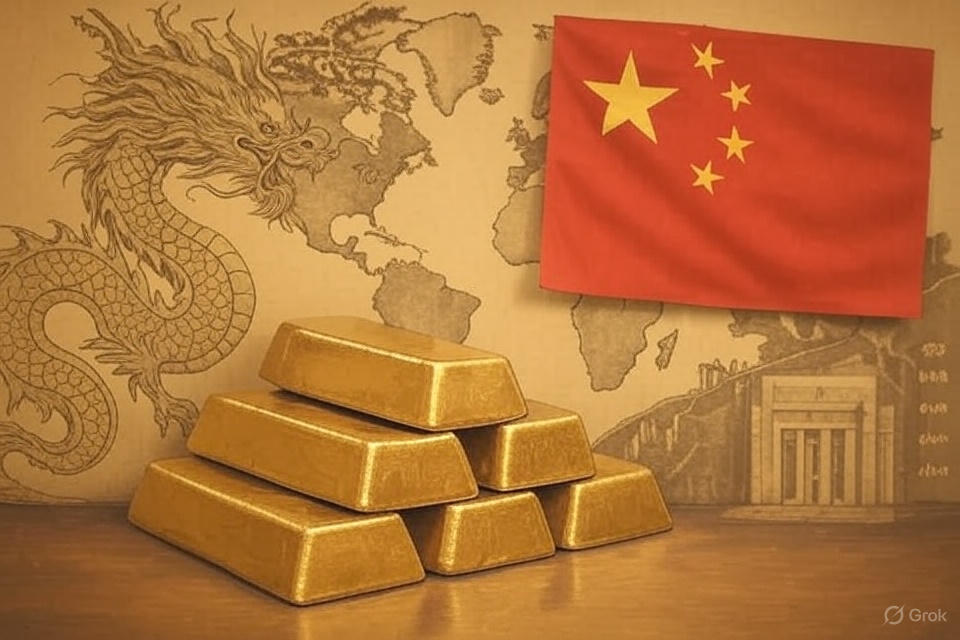China’s Gold Strategy: 7 Bold Moves to Challenge Dollar Dominance [2025]
Introduction
On September 24, 2025, entrepreneur and commentator Mario Nawfal published a viral post on X (formerly Twitter) highlighting China’s aggressive push toward global gold dominance. According to the tweet, gold prices surged past $3,700 per ounce, while China has been on a ten-month buying spree. More importantly, Beijing is now inviting "friendly" countries to store gold in Chinese vaults—a move that signals deeper ambitions to undermine the U.S. dollar and strengthen the yuan’s role in global trade.
Below is a detailed breakdown of the tweet, its imagery, and the broader implications for global finance.
🚨🇨🇳 CHINA PUSHES FOR GLOBAL GOLD DOMINANCE
— Mario Nawfal (@MarioNawfal) September 24, 2025
Gold just hit a fresh record above $3,700 an ounce, and China has been on a ten-month buying spree like it's stocking up for a storm.
The People’s Bank of China is asking “friendly” countries to buy gold and keep it in Chinese vaults… https://t.co/o3q7GABu6l pic.twitter.com/tJu8cu9LLL
1. Record Gold Prices Fueling the Strategy
- Gold touched a historic high of $3,700 per ounce, reflecting rising demand.
- China’s accumulation spree has amplified the surge, indicating not a short-term hedge but a long-term monetary shift.
2. A Ten-Month Buying Spree
- Reports suggest the People’s Bank of China (PBoC) has been consistently purchasing gold for ten straight months.
- Such sustained buying highlights Beijing’s systematic diversification away from the U.S. dollar.
3. Gold Vaults in China Over London & New York
- Traditionally, nations stored reserves in London or New York.
- China is now persuading “friendly” nations to move reserves into Chinese vaults—directly competing with Western financial hubs.
4. Offshore Vaults in Hong Kong
- Beijing has already established offshore gold vaults in Hong Kong.
- These facilities act as a bridge for global trading partners, easing accessibility outside mainland China.
5. Relaxed Import Rules to Centralize Trading
- China has eased import restrictions to draw more global gold trading under its control.
- This policy aligns with Beijing’s broader effort to make the yuan central to global commodity trade.
6. Gold as Geopolitical Leverage
- Gold reserves can be a backstop for nations under Western sanctions.
- Countries like Russia, facing frozen assets, could find Chinese vaults an alternative, thereby cementing Beijing’s geopolitical influence.
7. The Bigger Goal: Challenging the U.S. Dollar
- The U.S. dollar remains the world’s reserve currency, but China’s gold-driven strategy aims to chip away at its dominance.
- By building trust in the yuan backed by gold, Beijing could create a parallel financial system.
Images in the Tweet: Symbolism Explained
- World Leaders (Putin, Modi, Xi) – Suggests emerging partnerships that might align with China’s financial strategy.
- Stacks of Gold Bars – Reinforces the message of China’s accumulating reserves and storage ambitions.
🇨🇳 CHINA WANTS TO MAKE GOLD SHOPPING EASIER
— Mario Nawfal (@MarioNawfal) September 13, 2025
China’s central bank wants to make it easier to import and export gold by extending licences from six months to nine and letting them be reused at more customs offices.
That means fewer headaches for traders, since they won’t need a… pic.twitter.com/hfjyQDUH50
Public Reactions & Market Implications
- Skepticism: Some doubt whether nations would risk placing reserves in Chinese vaults.
- Support: Others view it as a much-needed alternative to Western systems.
- Crypto Advocates: Some argue Bitcoin remains a stronger hedge than gold.
The market impact is undeniable: gold prices soaring, investors watching closely, and central banks rethinking their strategies.
FAQs
Q1. Why is China buying so much gold?
China is diversifying away from the U.S. dollar and positioning the yuan as a stronger global currency.
Q2. How much gold does China currently hold?
Exact figures are not fully disclosed, but consistent monthly purchases show rapid accumulation.
Q3. Why store gold in Chinese vaults?
China offers this as an alternative to Western banks, especially for nations fearing sanctions.
Q4. Could this weaken the U.S. dollar?
Yes, if more countries adopt gold-backed yuan trade, it could gradually reduce dollar dominance.
Conclusion
China’s gold strategy—from record-breaking purchases to offering foreign vault services—signals a clear challenge to U.S. financial hegemony. While it remains uncertain whether nations will fully trust Beijing with their reserves, the geopolitical stakes are immense. The surge in gold prices above $3,700 is not just market speculation—it’s a reflection of deep structural shifts in global finance.
Opinion
The debate is far from over. On one hand, China’s gold-driven approach offers nations a lifeline against dollar dependency, potentially creating a more multi-polar financial system. On the other hand, skeptics argue that trusting Chinese vaults could be risky, especially given geopolitical rivalries, lack of transparency, and historical precedent.
Ultimately, the question is not just about gold or the dollar—it’s about whether the world is ready to transition from a U.S.-led system to one shaped by competing financial powers. If China succeeds, the implications will ripple across trade, diplomacy, and global security. If it fails, the surge in gold prices may prove temporary.
The world now watches: Will gold be Beijing’s golden ticket, or a glittering gamble?


0 comments